Bho Matthiesen
Gauss-Olbers Center, c/o University of Bremen, Dept. of Communications Engineering, , University of Bremen, U Bremen Excellence Chair, Dept. of Communications Engineering
6G Resilience -- White Paper
Sep 10, 2025Abstract:6G must be designed to withstand, adapt to, and evolve amid prolonged, complex disruptions. Mobile networks' shift from efficiency-first to sustainability-aware has motivated this white paper to assert that resilience is a primary design goal, alongside sustainability and efficiency, encompassing technology, architecture, and economics. We promote resilience by analysing dependencies between mobile networks and other critical systems, such as energy, transport, and emergency services, and illustrate how cascading failures spread through infrastructures. We formalise resilience using the 3R framework: reliability, robustness, resilience. Subsequently, we translate this into measurable capabilities: graceful degradation, situational awareness, rapid reconfiguration, and learning-driven improvement and recovery. Architecturally, we promote edge-native and locality-aware designs, open interfaces, and programmability to enable islanded operations, fallback modes, and multi-layer diversity (radio, compute, energy, timing). Key enablers include AI-native control loops with verifiable behaviour, zero-trust security rooted in hardware and supply-chain integrity, and networking techniques that prioritise critical traffic, time-sensitive flows, and inter-domain coordination. Resilience also has a techno-economic aspect: open platforms and high-quality complementors generate ecosystem externalities that enhance resilience while opening new markets. We identify nine business-model groups and several patterns aligned with the 3R objectives, and we outline governance and standardisation. This white paper serves as an initial step and catalyst for 6G resilience. It aims to inspire researchers, professionals, government officials, and the public, providing them with the essential components to understand and shape the development of 6G resilience.
Sparse Incremental Aggregation in Satellite Federated Learning
Jan 20, 2025


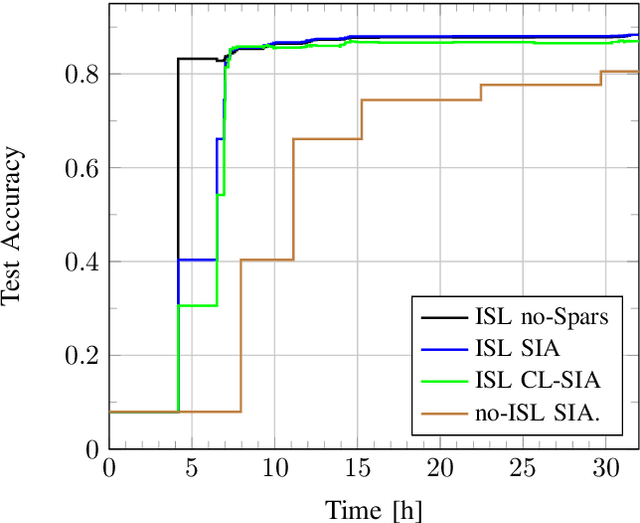
Abstract:This paper studies Federated Learning (FL) in low Earth orbit (LEO) satellite constellations, where satellites are connected via intra-orbit inter-satellite links (ISLs) to their neighboring satellites. During the FL training process, satellites in each orbit forward gradients from nearby satellites, which are eventually transferred to the parameter server (PS). To enhance the efficiency of the FL training process, satellites apply in-network aggregation, referred to as incremental aggregation. In this work, the gradient sparsification methods from [1] are applied to satellite scenarios to improve bandwidth efficiency during incremental aggregation. The numerical results highlight an increase of over 4 x in bandwidth efficiency as the number of satellites in the orbital plane increases.
Sparse Incremental Aggregation in Multi-Hop Federated Learning
Jul 25, 2024Abstract:This paper investigates federated learning (FL) in a multi-hop communication setup, such as in constellations with inter-satellite links. In this setup, part of the FL clients are responsible for forwarding other client's results to the parameter server. Instead of using conventional routing, the communication efficiency can be improved significantly by using in-network model aggregation at each intermediate hop, known as incremental aggregation (IA). Prior works [1] have indicated diminishing gains for IA under gradient sparsification. Here we study this issue and propose several novel correlated sparsification methods for IA. Numerical results show that, for some of these algorithms, the full potential of IA is still available under sparsification without impairing convergence. We demonstrate a 15x improvement in communication efficiency over conventional routing and a 11x improvement over state-of-the-art (SoA) sparse IA.
Scheduling for On-Board Federated Learning with Satellite Clusters
Feb 14, 2024Abstract:Mega-constellations of small satellites have evolved into a source of massive amount of valuable data. To manage this data efficiently, on-board federated learning (FL) enables satellites to train a machine learning (ML) model collaboratively without having to share the raw data. This paper introduces a scheme for scheduling on-board FL for constellations connected with intra-orbit inter-satellite links. The proposed scheme utilizes the predictable visibility pattern between satellites and ground station (GS), both at the individual satellite level and cumulatively within the entire orbit, to mitigate intermittent connectivity and best use of available time. To this end, two distinct schedulers are employed: one for coordinating the FL procedures among orbits, and the other for controlling those within each orbit. These two schedulers cooperatively determine the appropriate time to perform global updates in GS and then allocate suitable duration to satellites within each orbit for local training, proportional to usable time until next global update. This scheme leads to improved test accuracy within a shorter time.
Robust Precoding via Characteristic Functions for VSAT to Multi-Satellite Uplink Transmission
Jan 30, 2023



Abstract:The uplink from a very small aperture terminal (VSAT) towards multiple satellites is considered, in this paper. VSATs can be equipped with multiple antennas, allowing parallel transmission to multiple satellites. A low-complexity precoder based on imperfect positional information of the satellites is presented. The probability distribution of the position uncertainty and the statistics of the channel elements are related by the characteristic function of the position uncertainty. This knowledge is included in the precoder design to maximize the mean signal-to-leakage-and-noise ratio (SLNR) at the satellites. Furthermore, the performance w.r.t. the inter-satellite distance is numerically evaluated. It is shown that the proposed approach achieves the capacity for perfect position knowledge and sufficiently large inter-satellite distances. In case of imperfect position knowledge, the performance degradation of the robust precoder is relatively small.
A Comparison between RSMA, SDMA, and OMA in Multibeam LEO Satellite Systems
Jan 27, 2023Abstract:Low Earth orbit (LEO) satellite systems enable close to global coverage and are therefore expected to become important pillars of future communication standards. However, a particular challenge faced by LEO satellites is the high orbital velocities due to which a precise channel estimation is difficult. We model this influence as an erroneous angle of departure (AoD), which corresponds to imperfect channel state information (CSI) at the transmitter (CSIT). Poor CSIT and non-orthogonal user channels degrade the performance of space-division multiple access (SDMA) precoding by increasing inter-user interference (IUI). In contrast to SDMA, there is no IUI in orthogonal multiple access (OMA), but it requires orthogonal time or frequency resources for each user. Rate-splitting multiple access (RSMA), unifying SDMA, OMA, and non-orthogonal multiple access (NOMA), has recently been proven to be a flexible approach for robust interference management considering imperfect CSIT. In this paper, we investigate RSMA as a promising strategy to manage IUI in LEO satellite downlink systems caused by non-orthogonal user channels as well as imperfect CSIT. We evaluate the optimal configuration of RSMA depending on the geometrical constellation between the satellite and users.
Scheduling for Ground-Assisted Federated Learning in LEO Satellite Constellations
Jun 04, 2022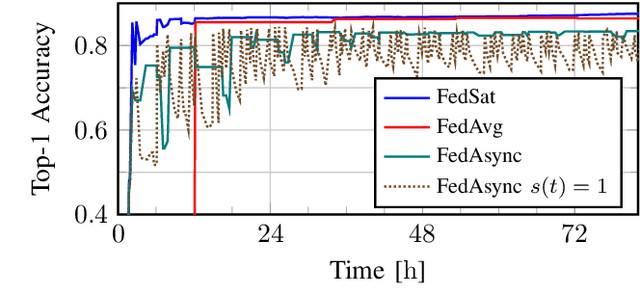
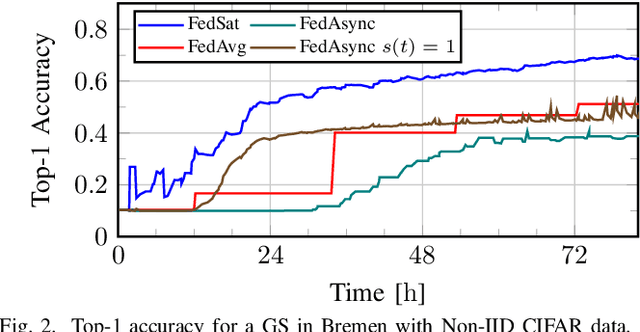
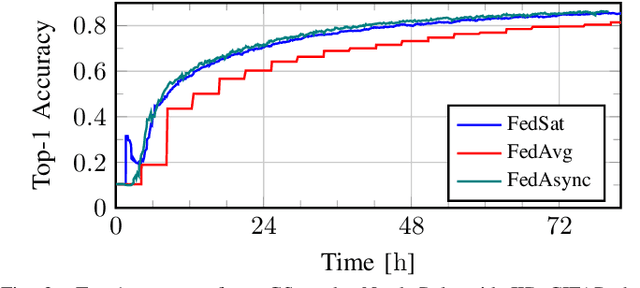
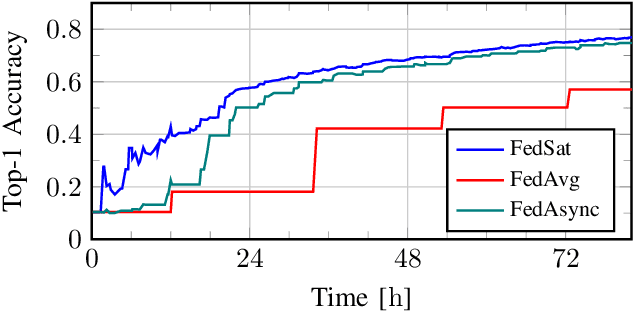
Abstract:Distributed training of machine learning models directly on satellites in low Earth orbit (LEO) is considered. Based on a federated learning (FL) algorithm specifically targeted at the unique challenges of the satellite scenario, we design a scheduler that exploits the predictability of visiting times between ground stations (GS) and satellites to reduce model staleness. Numerical experiments show that this can improve the convergence speed by a factor three.
Federated Learning in Satellite Constellations
Jun 01, 2022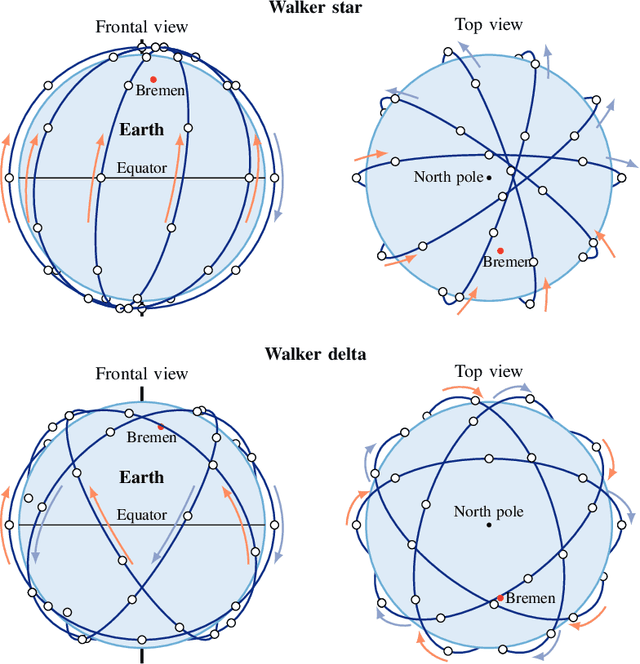
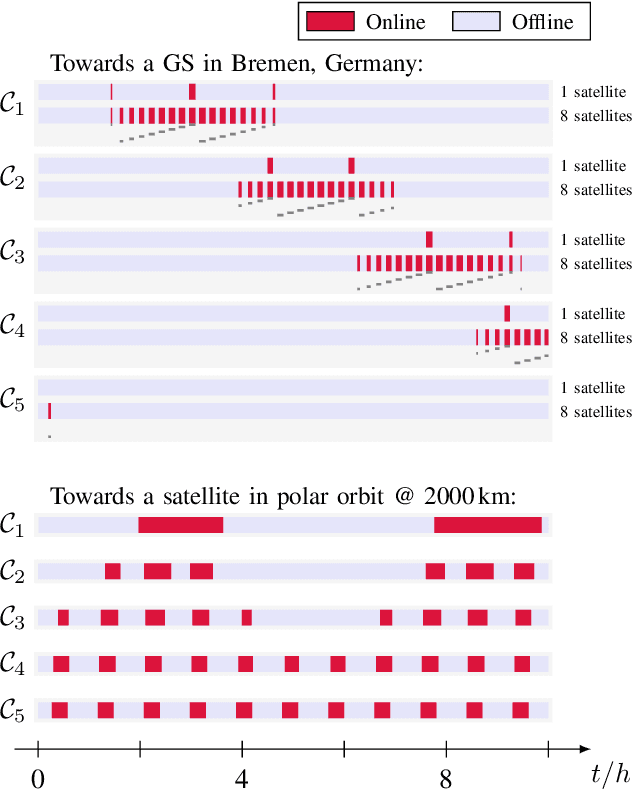
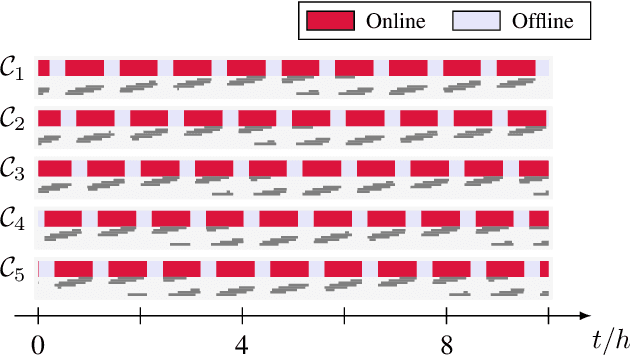

Abstract:Distributed machine learning (DML) results from the synergy between machine learning and connectivity. Federated learning (FL) is a prominent instance of DML in which intermittently connected mobile clients contribute to the training of a common learning model. This paper presents the new context brought to FL by satellite constellations where the connectivity patterns are significantly different from the ones assumed in terrestrial FL. We provide a taxonomy of different types of satellite connectivity relevant for FL and show how the distributed training process can overcome the slow convergence due to long offline times of clients by taking advantage of the predictable intermittency of the satellite communication links.
Distributed Downlink Precoding and Equalization in Satellite Swarms
May 23, 2022



Abstract:In this paper, we propose a novel approach for downlink transmission from a satellite swarm towards a ground station (GS). These swarms have the benefit of much higher spatial separation in the transmit antennas than traditional big satellites with antenna arrays, promising a massive increase in spectral efficiency. The resulting precoder and equalizer have very low demands on computational complexity, inter-satellite coordination and channel estimation. This is achieved by taking knowledge about the geometry between satellites and GS into account. For precoding, each satellite only requires its angle of departure (AoD) towards the GS and it turns out that almost optimal data rates can be achieved if the satellites transmit independent data streams. For the equalizer, the GS requires only knowledge about the angles of arrival (AoAs) from all satellites. Based on the underlying geometrical channel approximation, the optimal inter-satellite distance is obtained analytically. We show, that, by choosing a proper inter-satellite distance, the proposed low-complexity approach achieves the theoretical upper bound in terms of data rate. Furthermore, a novel approach to increase the robustness of the proposed precoder and equalizer against imperfect AoD and AoA knowledge is proposed, by exploiting the statistics of the estimation error.
NGSO Constellation Design for Global Connectivity
Apr 09, 2022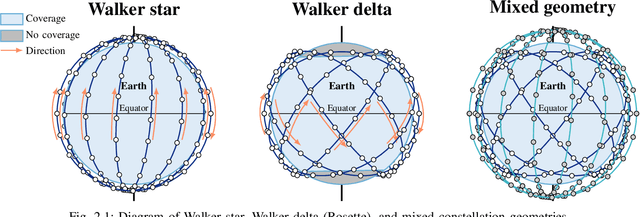
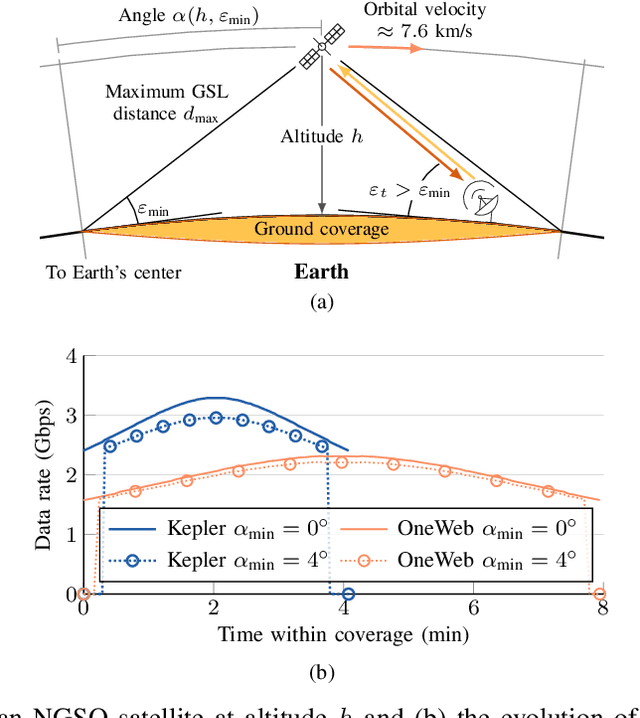

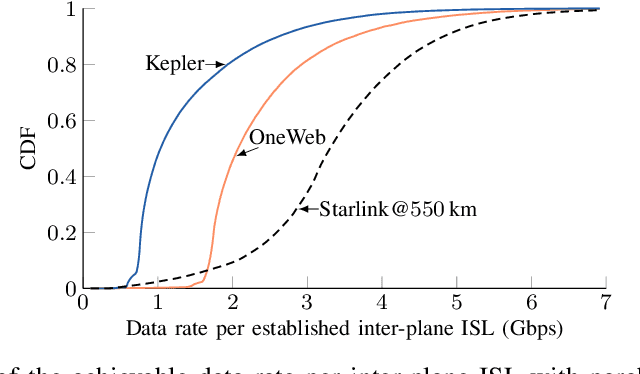
Abstract:Non-geostationary orbit (NGSO) satellite constellations represent a cornerstone in the NewSpace paradigm and thus have become one of the hottest topics for the industry, academia, but also for national space agencies and regulators. For instance, numerous companies worldwide, including Starlink, OneWeb, Kepler, SPUTNIX, and Amazon have started or will soon start to deploy their own NGSO constellations, which aim to provide either broadband or IoT services. One of the major drivers for such a high interest on NGSO constellations is that, with an appropriate design, they are capable of providing global coverage and connectivity.
 Add to Chrome
Add to Chrome Add to Firefox
Add to Firefox Add to Edge
Add to Edge